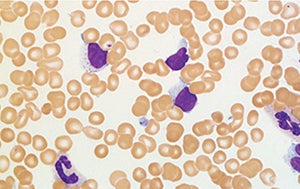Research Projects
Peripheral (PTCL) and Cutaneous T-Cell Lymphoma (CTCL)
Principal Investigators: Owen A. O’Connor, MD, PhD
PTCL occurs in fewer than 10,000 U.S. patients per year, and has a relatively low cure rate among lymphomas of approximately 25 percent. No dedicated treatment platform for PTCL has ever been developed. This transdisciplinary project seeks to identify new synergies between treatments, to develop new drugs, and to innovate a new paradigm in the care of patients with the disease. Program research led by Dr. O’Connor has already developed two new drugs, nano-romidepisin and nano-pralexatrate, and the initiative’s first combinatorial nano-therapeutic. Ongoing research focuses on areas including combination of epigenetic therapies with others such as immunotherapy, and on nano-scale drug delivery.
Large Granular Lymphocyte (LGL) Leukemia
Principal Investigators: Thomas P. Loughran, Jr., MD and David J. Feith, PhD
Dr. Loughran discovered LGL leukemia in the 1980s and has spent his career studying the disease and treating patients from around the world. Existing therapies have a response rate of approximately 50 percent, and many patients participate in months-long clinical trials only to find they have not responded. UVA has already identified biomarkers in patients most responsive to specific therapies. New research focuses on identifying other key biomarkers, and on tailoring treatments to individual patients’ genetics, which could include combined epigenetic and immunotherapy treatments, as well as nano-scale drug delivery. To learn more, visit the Loughran Lab and UVA Health’s LGL Leukemia Program.
NanoMedicine for Orphan Blood Cancers
Principal Investigator: Anuradha Illendula, PhD
Cancer nanomedicine creates “packages” smaller than 200 nanometers – about twice the size of the typical virus – that improve the delivery, toxicity and efficacy of cytotoxic, precision targeted and immunological therapies. Two such technologies developed by UVACCC and UVA’s nanoSTAR initiative have already entered the clinic for enhanced cancer imaging and therapy, including Ceraxa, a nontoxic nanoscale delivery system for ceramide that has demonstrated effectiveness in treatment of orphan blood cancers. Ongoing research focuses on increased production of nano-scale products to support clinical trials and development of next-generation nanotechnology.



